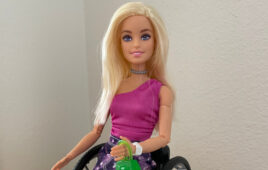I am five feet tall, on a good day, with the wind, as one of my best friends says. I sit on a pillow to drive my beloved Toyota Corolla. I have a footrest under my office desk, and another one at home.
When I was in high school, one of my teachers said if I’d been two inches shorter, my height would have qualified as a disability. I dismissed her comment, in part because that’s what 15-year-olds do, but also because my stature as a disability felt absurd. “I don’t feel short,” I told her.

Sheila Fitzgerald/Shutterstock.com
Ah, Boo Berry: a favorite worth climbing shelves for.
That’s still true. I usually feel my height is average, and that anyone more than a few inches taller than me is “quite tall.” But really, the reason I don’t “feel short” is because my height is commonly an issue in only two environments:
(1) When trying to put my bag into an overhead bin on a plane.
(2) When trying to reach less-popular items on high supermarket shelves.
Neither is much of an issue. I pack lightly and practice lifting my carry-on bag. And at the supermarket, I nudge boxes of corn flakes on the bottom shelf to make room for my feet as I climb to reach the Cap’n Crunch All Berries.
When this fails — and it does if the Cap’n is on a shelf that’s too high, or if there’s no room for a toehold on a lower shelf — I get help. I ask a store employee, if possible. But mostly, I ask other customers, even if they aren’t much taller than me. (Once, I recognized a retired NFL offensive tackle in the ethnic foods aisle who was way tall enough to grab the bottle of hot sauce I wanted. But I was too shy to ask.)
This prologue is due to the stunning frequency with which some folks “help” people with disabilities, including wheelchair users. On social media and in blogs, horror stories abound of people with low vision being yelled at or guided across streets they didn’t want to cross. People who use wheelchairs report getting pushed up ramps they didn’t want to ascend or could’ve managed themselves. Shepherd Center has a good-humored video about doorways and people who use wheelchairs: http://tinyurl.com/hdfrl9v. Comedian John Oliver, host of Last Week Tonight, did a spot on behalf of the Cerebral Palsy Foundation on how to start a conversation with someone who has a disability.
“Don’t speak extra loud, as if you think being in a wheelchair is somehow the same as wearing noise-canceling headphones,” Oliver said. “Essentially, the best thing to do is…just say hi.”
These examples are gently good natured, but at the root of it all, I realized — people need these public service announcements. Because people with disabilities are suffering others’ foolish assumptions all the time.
If someone began throwing canned goods and leafy greens into my cart though I didn’t ask for help, I might chuck the kale back at them. What is it about a disability that makes so many other people abandon common sense and basic courtesy?
I suspect that people with disabilities often find the biggest challenges to be not the clinical terminology in their medical files, but the misconceptions of supposedly well-intentioned folks around them. This is our annual Accessibility issue, full of technology and solutions that can actually help. Here’s hoping that accessibility theme extends to our minds and hearts, as well.

